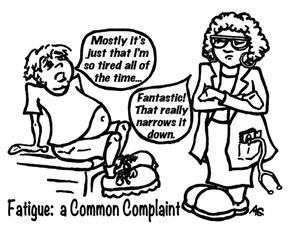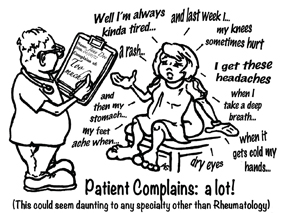
How do we help these patients with poorly understood illnesses find hope? What are the new clinical tools and systems that will help us assess and modulate factors affecting immune system imbalance?
Stormy drove more than 200 miles to be my official last patient in the mid-afternoon. She brought me handmade, embroidered and personalized snack pouches for every rider on TeamOverman, who would soon be cycling the People’s Coast Classic the length of Oregon in support of the Arthritis Foundation.2 This visit is to be a time for stories and hugs, but her pre-visit questionnaire shows major dysfunction on the RAPID questionnaire, and her pain is 10/10. She limps, and her left forefoot is swollen. Neither X-ray nor ultrasound confirms her self-diagnosis of a stress fracture. Ultrasound demonstrates a swollen, inflamed metatarsal-cuneiform joint directly in the area of tenderness. After a bupivacaine and triamcinolone injection, she walks across the room without pain.


In 10 years, will ultrasound be used by all rheumatologists? Will this be done by her primary physician and interpreted via a telemed visit, saving her the painful three-hour drive?
[Patients with musculoskeletal disorders] invite new innovations in patient-centered, comprehensive, conservative care services.
I finally catch up with the very active listserv that is focused on the frustrations of time-consuming Medicare documentation requirements, the costs of preauthorization advocacy and the strategies for fighting or working with big insurance companies. We are burdened by complex patients, required data elements for each moderately complex patient (a listserv math major calculates 5,376) and healthcare administrators who discount physicians. Members are encouraged to support the ACR advocacy efforts, to form super groups, to diversify away from the infusion business and to take responsibility for self-regulation. As an example of such efforts, Howard Kenney, MD, describes how the Washington Rheumatology Alliance, under the leadership of Jeff Peterson, MD, has launched a Rheumatology Medical Home Demonstration Project to work with insurers and primary care physicians to “refine our delivery of rheumatic disease care within a rheumatology care model.”3
What is the “rheumatology care model,” and will it meet the needs of an evolving healthcare system focused on value? What collaborations are you building for the future?
That evening, I toast my nurse, Claudia, and all our patients who want to stay with her and her new doctor. In the words of the Arthritis Foundation (AF) and its new brand, our nurses are the champions of yes. “Yes, I care; yes, I will get your refills; yes, I understand how stressed you are; yes, I will get you the answers; yes, I will get you worked in; yes, we will appeal the denial; and yes, I am here for you.”


